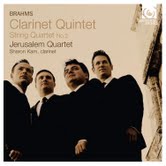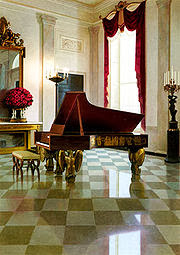In Review--Wood, Wind & Strings
Classical
Jerusalem Quartet
Sharon Kam
Brahms Clarinet Quintet
String Quartet, No. 2
Harmonia Mundi
Jerusalem Quartet
Sharon Kam
Brahms Clarinet Quintet
String Quartet, No. 2
Harmonia Mundi
The clarinet is among the most versatile instruments showing
up in classical, baroque, jazz, world, gypsy and klezmer music. On Jerusalem Quartet’s recording of Brahms Clarinet Quintet featuring
clarinetist Sharon Kam, the wind instrument takes on a chameleon role blending
in with the strings so well, that at times I can barely detect its warm
tones. I’m reminded of the solitary
clarinet of Mozart’s Clarinet Concerto,
not knowing why exactly since Brahms doesn’t send his clarinet on flights of
fancy and the clarinet portrays adult sobriety as opposed to Mozart’s childlike
glee. Brahms, for whatever reason, refrains
from shining the virtuoso spotlight on the instrument, and this is during an
era when fiery musicianship on a soloing instrument was the norm.
The musical conversation of the Clarinet Quintet holds my attention nonetheless, even with the
sober tones, and the melding of the violin and clarinet into a single sound at
times, and at other times, the clarinet shadows the violin, repeating the same
motif while the other strings swell in the background. In the final movement, the cello takes the
lead (and listeners are treated to cellist Kyril Zlotnikov performing on the
late Jacqueline du Près’ cello).
Overall, this quintet feels relaxing because it moves at an even pace,
and the soft diffusion at the beginning of the Adagio movement foreshadows the
French Impressionist composers--this opening reminds me of passing reflections
of clouds on a still lake. The romantic
tones recall Elgar and Grieg’s work in that this quintet could easily slip into
the soundtrack of romantic cinema, as easily, as it could appear on a
relaxation CD featuring classical composers.
Brahms second string quartet accompanies the quintet, but instead of showing unity between Brahms two compositions, we hear a contrast in mood, tone, and structure. I had to concentrate more on the string quartet because of the rich polyphonies dancing between the four instruments. When I say dancing, I’m not making light of this weighty composition, which even with its beautiful moments does not bring on sighs or smiles. I held my breath at times because of the sadness that the strings conveyed, though a few passages throughout the four movements felt somewhat lively. The meticulous Brahms composed complicated musical architecture that chose a non-linear path here.
Since I never studied music composition and music theory wasn’t exactly a subject I excelled in, I’ll leave the technical details to the experts. Suffice to say that I enjoyed listening to both the string quartet and clarinet quintet which lead me to read Brahms’ biography. I learned that the composer was just as complicated and contradictory as his music.




Comments
Post a Comment